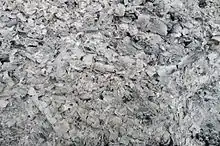Ash
Ash or ashes are the solid remnants of fires.[1] Specifically, ash refers to all non-aqueous, non-gaseous residues that remain after something burns. In analytical chemistry, to analyse the mineral and metal content of chemical samples, ash is the non-gaseous, non-liquid residue after complete combustion.

Ashes as the end product of incomplete combustion are mostly mineral, but usually still contain an amount of combustible organic or other oxidizable residues. The best-known type of ash is wood ash, as a product of wood combustion in campfires, fireplaces, etc. The darker the wood ashes, the higher the content of remaining charcoal from incomplete combustion. The ashes are of different types. Some ashes contain natural compounds that make soil fertile. Others have chemical compounds that can be toxic but may break up in soil from chemical changes and microorganism activity.
Like soap, ash is also a disinfecting agent (alkaline).[2] The World Health Organization recommends ash or sand as alternative when soap is not available.[3]
Natural occurrence
Ash occurs naturally from any fire that burns vegetation—ignited by lightning, volcanic activity, or other processes. Ashes may eventually disperse in soil to make it fertile, or may remain intact under soil for a long time—even long enough to turn into coal.
Specific types
- Wood ash
- Products of coal combustion
- Bottom ash
- Fly ash, product of coal combustion
- Breeze, ash from burning urban rubbish
- Cigarette or cigar ash
- Incinerator bottom ash, a form of ash produced in incinerators
- Ashes and dried bone fragments, or "cremains", left from cremation
- Volcanic ash, ash that consists of glass, rock, and other minerals that appears during an eruption, black soil which is the result of the volcanic eruption and comprises ash and other volcanic material.
See also
- Cinereous, consisting of ashes, ash-colored or ash-like
- Potash, a term for many useful potassium salts that traditionally derived from plant ashes, but today are typically mined from underground deposits
- coal, consisting of carbon as ash, and ash can be converted into coal
- carbon, basic component of ashes
References
- "the definition of ash". www.dictionary.com. Retrieved 2018-06-18.
- Howard et al. 2002: Healthy Villages A guide for communities and community health workers. CHAPTER 8 Personal, domestic and community hygiene. WHO. Accessed Oct. 2014. http://www.who.int/water_sanitation_health/hygiene/settings/hvchap8.pdf
- WHO 2014: Water Sanitation Health. How can personal hygiene be maintained in difficult circumstances? Accessed Oct. 2014 http://www.who.int/water_sanitation_health/emergencies/qa/emergencies_qa17/en/
